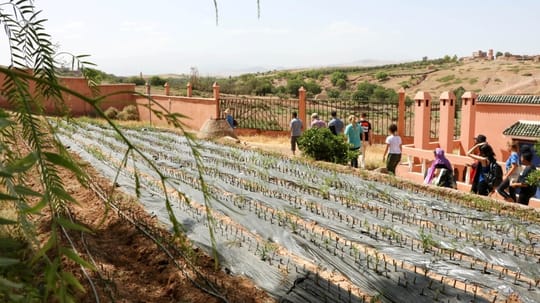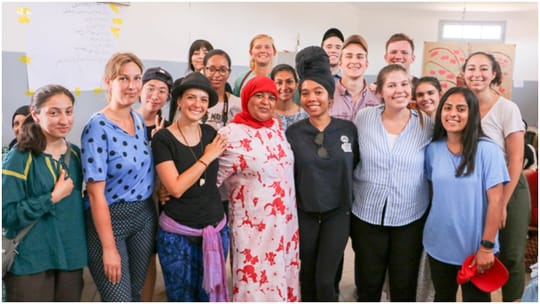HAF Intern
On a hot sunny day of May 30, 2019, the group accompanied by Errachid Montassir and Amina El Hajjami, left HAF Office in Marrakech by 9 o’clock in the morning, towards the Amazigh village of Akrich. The drive took about 30 min to get to the village.

The first site visited was the HAF tree nursery, which grows pomegranate and fig saplings to cover community and school garden needs in different parts of Morocco. The nursery is established on a land adjacent to 700-year old mausoleum of Rabbi Raphael Cohen, which is a land area that is granted in-kind by the Moroccan Jewish community. The yearly production is about 25,000 of pomegranate and fig saplings.

Organic agriculture production is the ultimate community target and the best way to add value to local products. One of the obstacles that the community with HAF is working to address is the building of knowledge and capacities regarding organic cultivation, to assist in securing certification of their product.
The group visited the mausoleum where Jewish people from around the world come together each year to celebrate and pray. This creates links between local population and the Jewish pilgrims, which results in many cooperation acts; the provision of land for the establishment of the nursery in Akrich is an eloquent example in this respect. Abderrahim Beddah, the caretaker, told us about how Jews cry when they come to the mausoleum or when it is time to leave. They feel a deep connection to their Moroccan roots.
The UVA students were surprised to learn that Moroccans think about the cultural connections between Jews and Moroccans, while it is always about political issues discussions back in the USA.

At a second site, the group visited a women’s cooperative at Achbarou. It was initially a men’s association before where they held literacy classes for women and established a kindergarten.
Ms. Monica from Argentina accompanied the group to the cooperative where she tutored the women on how to use natural dye to color wool in a safe way. This included training in how to extract the dyes naturally and how to use them on wool to be sold or used in making carpets.
Ms. Miryam, an artist from Netherlands, also accompanied us. She sees colors in people and uses them when she draws her portraits. She is planning to paint a portrait to show women’s strength. There were also young girls who stopped going to school and are now learning embroidery with Ms. Fatima, a volunteer trainer in the cooperative.

Ms. Lalla, a woman who is running another cooperative nearby teaches a class for little girls and literacy for older women. A group of women who worked with wool also greeted the group.
Everyone was very pleased to be there. In addition, the women were happy to see us and the young girls were so happy to interact with UVA students. Before leaving, we all took a group photo with the women.

At a second site, the group visited a women’s cooperative at Achbarou. It was initially a men’s association before where they held literacy classes for women and established a kindergarten.
Ms. Monica from Argentina accompanied the group to the cooperative where she tutored the women on how to use natural dye to color wool in a safe way. This included training in how to extract the dyes naturally and how to use them on wool to be sold or used in making carpets.
Ms. Miryam, an artist from Netherlands, also accompanied us. She sees colors in people and uses them when she draws her portraits. She is planning to paint a portrait to show women’s strength. There were also young girls who stopped going to school and are now learning embroidery with Ms. Fatima, a volunteer trainer in the cooperative.
Ms. Lalla, a woman who is running another cooperative nearby teaches a class for little girls and literacy for older women. A group of women who worked with wool also greeted the group.
Everyone was very pleased to be there. In addition, the women were happy to see us and the young girls were so happy to interact with UVA students. Before leaving, we all took a group photo with the women.
